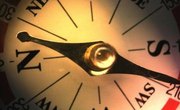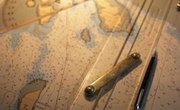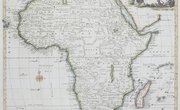Tips to Remember Latitude and Longitude
They run north to south and east to west, but which is which in the world when you are plotting a trip or sailing the seven seas? It can be confusing to remember the difference between latitude and longitude. They both start with the same letter and have the same number of syllables and the same definition, to a degree. The main difference in the definitions of latitude and longitude is the direction. Some can use mnemonic devices to help them remember the difference. Latitude and longitude coordinates are used to pin exact locations of things on a large scale map.
Basics of Latitude vs. Longitude
The lines of latitude run east to west, or are horizontal lines. Consider them to be the steps or rungs on a ladder that fits snugly around the entire world. The lines of longitude run from north to south, or are vertical lines. They are the poles that hold the ladder steps together. These lines help determine the flatitude of a location on the globe or world map.
Which Way is Latitude?
The first syllable of the word "latitude" sounds a bit like the word "ladder." This is a way to remember that latitude is the steps that run around the world from east to west. To read latitude degrees, you will know how far north or south you are traveling from a point. The North Pole is at 90 degrees north latitude. The South Pole is at -90 degrees latitude. If you have a negative sign in front of a latitude degree, then you know you are in the southern hemisphere. Reverse that to know how far north you are from the equator. They act as imaginary vertical lines, dividing the north-south areas of a globe and world map.
A long-standing rhyme to remember latitude is: “I’m climbing the ladder of latitudes, latitudes, latitudes. I’m climbing the ladder of latitudes, all around the world.”
Longitude Meaning for Map Reading
Longitude is the angular distance from Greenwich, England that runs east to west. It is the measurement east or west of the prime meridian. The farther north or south you go, the farther away the longitude degrees will be. The imaginary meridian lines connect the North and South poles. They help pilots and ship captains navigate the world at sea, in the air and on land. Zero degrees longitude is the Prime Meridian on the surface of the Earth.
A rhyme to assist in remembering longitude is: “It’s a long, long way from pole to pole, pole to pole, pole to pole. It’s a long, long way from pole to pole, so we call those longitudes.”
Equator for Everyone
The equator is the waist of the body of the world. It runs directly around the middle of the globe. It divides north from south and runs nonstop like a train from east to west. The equator is the hottest part of the planet. The polar opposite is the polar caps, which are at the top and bottom of the longitude lines. Therefore, the equator is a latitude of warm weather that winds a hot band around the middle of the rotating earth. The zero-degree latitude line is where all latitude lines start, ending at the top of the globe at the ice caps in both southern and northern directions.
A Poem to Help Remember Degrees
A rhyme to remember latitude and longitude can help students just learning the ways of the world. There are many limericks, poems or verses that students can memorize to help understand latitude and longitude. Children have long learned about longitude and latitude by memorizing a poem by Jacquie Eaton. The poem easily breaks down the complex issues of the geographical lines.
“The longitude lines go up and down,
While the latitude lines go round and round.
The International Dateline and the Prime Meridian,
Split the Earth down the middle like a hotdog bun.
Now wait a minute…did I hear you say?
The Equator splits it the hamburger way.
History, anthropology, archaeology
Geography, psychology, sociology.
People, places, things and ideas,
That’s what Social Studies is.”
Related Articles
References
Writer Bio
Kimberley McGee is an award-winning journalist with 20+ years of experience writing about education, jobs, business trends and more for The New York Times, Las Vegas Review-Journal, Today’s Parent and other publications. She graduated with a B.A. in Journalism from UNLV. Her full bio and clips can be seen at www.vegaswriter.com.










